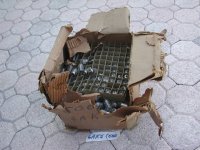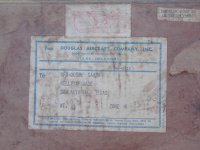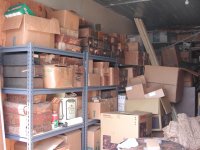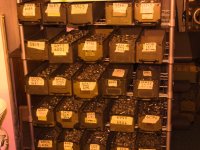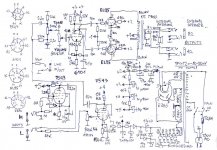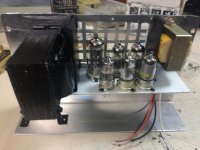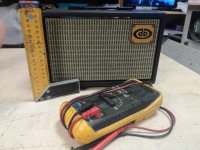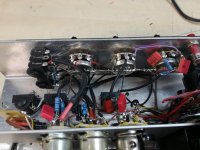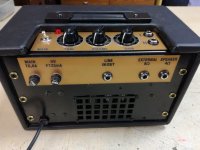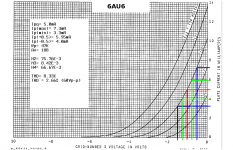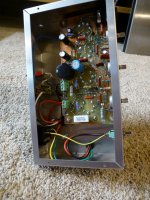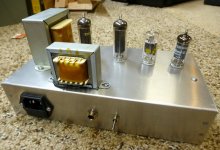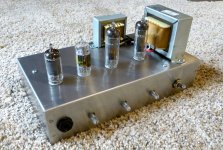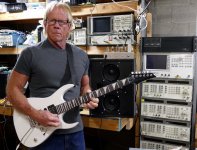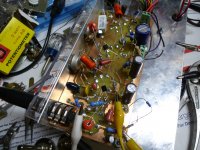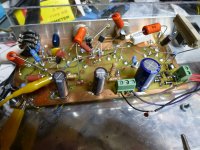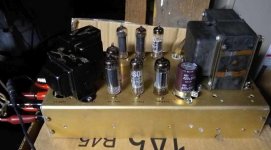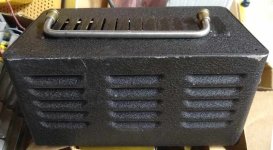The 6AU6 hits a sweet spot in specifications which is hard to match in any other small signal pentode. Makes it an excellent candidate for a partial feedback/schade style amp. There are almost no small signal pentodes which can pass reasonable amounts of current like the 6AU6 and its family. Still cheap as chips. Its said to be microphonic - but I have never had one that is.
Shoog
Shoog
The 6AH6 is a nice tube. I just bought a bunch of Russian equivalents (6J5P) because they were so cheap. 20 for $12 including shipping.
Thanks George. What were some of the others on that list? If it's not a secret...🙂
There was a paper list....over 20 years ago. It might still exist somewhere, but after 20 years and two moves totaling 1200 miles, I have no idea where it is.
Around 2000 I got a call from an old high school friend who lived over 200 miles away. We used to dumpster dive and hunt the junkyards, surplus stores, and military scrap yards together in the 60's and 70's. He had bought the contents of two large warehouses that were abandoned and being demolished. He had a short deadline to move it all, and one was full of tubes. Would I help move stuff? It would be a 500 mile round trip commute. Would I do it if I got all of the tubes for free?
In retrospect, it was a bad choice, but I spent 4 weekends digging through bird and rat poop moving stuff out of some heavily vandalized warehouses, returning each Sunday night with a U-Haul full of tubes.....lots of tubes, over 100,000 tubes (estimated by weight). I rented two 10 X 20 foot warehouse bays just to hold them all, and it took nearly 5 years of weekends just to sort them all and toss the broken, corroded, or otherwise obviously bad stuff.
Here are a few pictures of my haul. There were rat eaten boxes full of new tubes. Large boxes full of random loose tubes, and a few oddities, like an unopened box from the Douglas Aircraft Company to an AFB in Texas with a postmark date of 1937. It contained 4 NIB Western Electric branded 6V6GT tubes, which looked like RCA's to me. They went on Ebay, shipping box and all. There were hundreds of large tubes, like the pictured 833A, 211's, 845's and 813's smashed all over the warehouses where the vandals had been partying. I first sorted all the tubes by size. Then sorted by type number into these labeled totes.
Keeping all of these was not feasible since warehouse rent was more than most of the tubes were worth, and I knew that my career was on life support and we would leave South Florida when it ended.
As the sorting progressed, I started choosing what tubes I would possible use in my lifetime, and selling, giving away, or trashing those that I would never use. That's where the "list" came from. It was based on tubes that I had lots of, and may or may not need......what do you do with several thousand 6AL5's. I took a pickup truck full to all of the local hamfests for a couple years, selling them cheap, or even giving them to someone who would use them. I traded a whole truck full of old metal radio tubes to a guy for a guitar at one hamfest.
Numbers that I remember from my "keeper" collection for driver use include the 6J4, 5842 (used in the TSE and TSE-II), 12BY7, 12AY7, 12AX7, 12AT7 (used in the SSE and SPP), 5847, 6AB4, 5814, 5751, 6AU6, 5670, 5686, 6J6, 6CL6, 7044, 7119, 6AH6, 5687, and 6DJ8. Some of these are well known, and some are not. Many common driver tubes are not here simply because I didn't have many.
Attachments
The 6AU6 hits a sweet spot in specifications which is hard to match in any other small signal pentode. Its said to be microphonic - but I have never had one that is. Shoog
It's probably pretty tame in most applications, but they all sing when run at a stage gain in the 500 to 4000 V/V range with two gain stages after them.....yeah, its a screamin guitar amp....in more ways than one. The pentode is running open loop with a near infinite load impedance.
In Schade arrangements they are run always at low gains but high currents to resist the feedback currents. Then they never sing in the way you describe.
Shoog
Shoog
Everything except the rectifier (EZ80 which is 9-pin) is 7-pin: 7543x2, 6101 and EL95x2!
Attachments
The 6AU6 hits a sweet spot in specifications which is hard to match in any other small signal pentode. Makes it an excellent candidate for a partial feedback/schade style amp. There are almost no small signal pentodes which can pass reasonable amounts of current like the 6AU6 and its family. Still cheap as chips. Its said to be microphonic - but I have never had one that is.
Shoog
The 6AU6 is a reliable workhorse that does just about everything well: CCS, small signal audio amp and RF applications. The 200VHK is also convenient if using it as an error amp in an active voltage regulator. It even works as a pseudotriode with a u-factor that falls nicely between the 6SN7 and 6SL7 when you need a singleton triode. The spec sheet, however, doesn't mention audio:
The plate characteristics provided with the spec sheet is for doing such designs. However, good audio loadlines can be found (attached). The 8.33% THD estimate may look high, but that's on the basis of 188VPP. It decreases when you need less output swing. You could probably improve on that if you set up to adjust screen voltage and bias.The 6AU6A is a miniature sharp cutoff pentode primarily designed for use as a high gain RF or IF amplifier. Its low grid-plate capacitance and high transconductance make it especially suited to high frequency, wide band applications
Not as "sexy" as a more exotic type, but it just works, and well worth having in your hollow state collection.
Attachments
Maybe a 6X4/EZ90 might also fit and will convert your amplifier into a true 7 pin device?Everything except the rectifier (EZ80 which is 9-pin) is 7-pin: 7543x2, 6101 and EL95x2!
Best regards!
6x4 is an excellent little rectifier, I have run my preamp with four ECF80's for years off a single one. Onto the third set of main valves at this stage.
Shoog
Shoog
Here is my little 4 tube, 4 watt screamer. All tubes are 7 pin miniatures from the last generation of the AA5 vacuum tube radio. These tubes are still on the dollar menu since the silicon takeover came quickly leaving plenty of tubes in the pipeline.
The entire amp runs from the output of a $16 Triad N-68X. The heaters are fed FW rectifier, but unfiltered DC to reduce the peak currents in the transformer (360 degree conduction for the tube heaters).
The amp gets 155 to 170 volts of B+ from the rectified and filtered transformer output. The preamp section runs downstream of the screen grid dropping resistor in the output stage. When the output tubes see hard clipping the screen current goes way up. This drops the B+ on the preamp from about 150 volts to about 110 volts in maximum overdrive, creating a overabundance of "sag" for long sustaining notes.
The phase inverter is a mosfet, as is the active load on the input pentode.
That load is a circuit often called a gyrator. It provides a constant plate voltage determined by the R6 - R7 voltage divider. The parallel combination of those resistors in series with the resistance of the 1 meg pot determine the bulk of the AC load. The pot controls the stage gain, with some minor influence from the single knob tone control. Maximum stage gain can be nearly 1000 which does lead to microphony on every tube I have tried. If they aren't microphonic when you first install it, it will be after it lives on top of the speaker cabinet for a while. The 18FW6 is a 6AU6 with an 18 volt 100 mA heater. These are also useful for devices that run from a common laptop brick.
The tone control has a widely varying input impedance that varies with setting, and frequency. it is buffered by the active load mosfet, but still influences the gain and distortion characteristics of the input stage. The tone knob goes from a high pass filter configuration with the pot's wiper at ground to a low pass configuration at the other extreme with all sorts of funk in the middle. The 47K grid stopper on the 18FY6 is needed to prevent grid blocking when hit with a 70 volt P-P square wave. The 18FY6 is a 6AV6 with an 18 volt heater, which is 1/2 of a 12AX7 plus two (unused) diodes. It feeds a master gain pot.
The PI feeds a typical push pull amp stage with a pair of 32ET5 tubes. The OPT is a $5 70 volt line transformer from parts express. This amp can be built for well under $100 including the chassis and cabinet.
These three controls plus the volume knob on the guitar allow for a lot of tonal variation. It took me two or three weeks with three guitars, and a hand full of pots and a bag of caps to arrive at the component values seen in this amp. A different player with different speakers may prefer a different set of parts.
The amp can be seen here sitting on top of the speaker cabinet.
The remains of the prototype can be partially seen on top of the spectrum analyzer behind my head. The OPT is to the right of my left ear. The last two pictures show the prototype being "tuned up" with pots and caps. Those orange things that look like 3 watt resistors are mylar caps.
The entire amp runs from the output of a $16 Triad N-68X. The heaters are fed FW rectifier, but unfiltered DC to reduce the peak currents in the transformer (360 degree conduction for the tube heaters).
The amp gets 155 to 170 volts of B+ from the rectified and filtered transformer output. The preamp section runs downstream of the screen grid dropping resistor in the output stage. When the output tubes see hard clipping the screen current goes way up. This drops the B+ on the preamp from about 150 volts to about 110 volts in maximum overdrive, creating a overabundance of "sag" for long sustaining notes.
The phase inverter is a mosfet, as is the active load on the input pentode.
That load is a circuit often called a gyrator. It provides a constant plate voltage determined by the R6 - R7 voltage divider. The parallel combination of those resistors in series with the resistance of the 1 meg pot determine the bulk of the AC load. The pot controls the stage gain, with some minor influence from the single knob tone control. Maximum stage gain can be nearly 1000 which does lead to microphony on every tube I have tried. If they aren't microphonic when you first install it, it will be after it lives on top of the speaker cabinet for a while. The 18FW6 is a 6AU6 with an 18 volt 100 mA heater. These are also useful for devices that run from a common laptop brick.
The tone control has a widely varying input impedance that varies with setting, and frequency. it is buffered by the active load mosfet, but still influences the gain and distortion characteristics of the input stage. The tone knob goes from a high pass filter configuration with the pot's wiper at ground to a low pass configuration at the other extreme with all sorts of funk in the middle. The 47K grid stopper on the 18FY6 is needed to prevent grid blocking when hit with a 70 volt P-P square wave. The 18FY6 is a 6AV6 with an 18 volt heater, which is 1/2 of a 12AX7 plus two (unused) diodes. It feeds a master gain pot.
The PI feeds a typical push pull amp stage with a pair of 32ET5 tubes. The OPT is a $5 70 volt line transformer from parts express. This amp can be built for well under $100 including the chassis and cabinet.
These three controls plus the volume knob on the guitar allow for a lot of tonal variation. It took me two or three weeks with three guitars, and a hand full of pots and a bag of caps to arrive at the component values seen in this amp. A different player with different speakers may prefer a different set of parts.
The amp can be seen here sitting on top of the speaker cabinet.
The remains of the prototype can be partially seen on top of the spectrum analyzer behind my head. The OPT is to the right of my left ear. The last two pictures show the prototype being "tuned up" with pots and caps. Those orange things that look like 3 watt resistors are mylar caps.
Attachments
It occurred to me to install all 7-pin tubes in the amplifier, including the rectifier. The EZ90 / 6X4 is for permanent rectified current of 70mA, and the Russian 6C4P (also 7-pin) for 75mA, which is not enough for me in this amplifier because my maximum consumption exceeds ~ 80mA. I used the EZ80 / 6V4 (EI-Nis NOS-NIB) which I had and which is for 90mA, and I did not have its 7-pin replacement EZ91 / 6AV4.Maybe a 6X4/EZ90 might also fit and will convert your amplifier into a true 7 pin device?
Best regards!
6AU6 is a repackaged venerable 6J7/6SJ7. 6AH6 is a repackaged venerable 6AC7.
I heard a rumor that 6C5 and 6J5 were designed to replace them triode-strapped, with lower capacitnces.
I heard a rumor that 6C5 and 6J5 were designed to replace them triode-strapped, with lower capacitnces.
Last edited:
And the 6AB4 is 1/2 of a 12AT7. As stated before, the 6AV6 is 1/2 of a 12AX7 if you ignore the diodes.
The diyAudio community is split on whether to connect them to the cathode, or ground the diode plates. I simply leave them floating. They use a separate part of the cathode, so who cares if they die a zero emission death.
The diyAudio community is split on whether to connect them to the cathode, or ground the diode plates. I simply leave them floating. They use a separate part of the cathode, so who cares if they die a zero emission death.
Here in the US a 6J4 is a 7 pin high Gm triode that does very good for audio amp duty. I have a bunch of them. Back when I was developing the original TSE amp design I went through about 100 different tubes to find the best driver tube choice for a single stage driver that feeds a 45, 2A3 or 300B tube. I settled on the 5842, but the 6J4 was in the top ten list. It might have been further up the list if decent 7 pin PC board sockets were available in 2003.
The 6J4 was used in some military applications, so there are high spec versions available. The 6J4WA and the 8532 are the mil spec versions.
6J4WA has excellent potential but seems to have not linear curves on datasheet. The same goes for the old 6J4. Could you find more linear values with the help of the instrumentation?
Last edited:
I have this unnatural urge to build an all 7-pin amp based on the Mullard design. Say a 6AU6 front end, 6J6 LTP with a CCS at the tail, driving a pair of 6AQ5 tubes. The rectifier gets a little dicey, maybe a pair of 6X4 tubes per channel? Funnier would to make it into a pair of little monoblocks.
I have this unnatural urge to build an all 7-pin amp based on the Mullard design. Say a 6AU6 front end, 6J6 LTP with a CCS at the tail, driving a pair of 6AQ5 tubes. The rectifier gets a little dicey, maybe a pair of 6X4 tubes per channel? Funnier would to make it into a pair of little monoblocks.
Well I'll tell you, we live in a Townhouse now after downsizing from a damn suburban McMansion (money pit). Formerly we had space with no purpose, now we have to use the Oriental art of Feng Shui even in deciding how big of a blender we buy for the kitchen. The biggest issue for many people with tube amps is that they just dont have the room for them. This sounds like a cool project.
I did build a PP-amp with the excellent 6AQ5 (6BQ5 on diet) after Frank Nachbaurs simple schematic with an 6X8 as input/phase-inverter.
My build: 6AQ5 SE
Nachbauer's paraphase: Paraphase Splitter Experiments
Unfortunately the 6X8 has to be a noval, but using a 7-pin pentode and a 7-pin pentode whould fix that.
I happened to sell the mains transformer and I haven't replaced it. Mains tranny was from a Heathkit AA-32.
My build: 6AQ5 SE
Nachbauer's paraphase: Paraphase Splitter Experiments
Unfortunately the 6X8 has to be a noval, but using a 7-pin pentode and a 7-pin pentode whould fix that.
I happened to sell the mains transformer and I haven't replaced it. Mains tranny was from a Heathkit AA-32.
I have this unnatural urge to build an all 7-pin amp based on the Mullard design. Say a 6AU6 front end, 6J6 LTP with a CCS at the tail, driving a pair of 6AQ5 tubes. The rectifier gets a little dicey, maybe a pair of 6X4 tubes per channel? Funnier would to make it into a pair of little monoblocks.
Well, we all have strange urges now and then. I happened to have a chassis with mostly 7-pin socket holes, so built this amp: 1/2 6CG7 direct-coupled to a 6J6 phase inverter, push-pull 6AQ5s with fixed bias. Had to settle for a small pair of output transformers for space reasons. Used the E90CC since I had a few, makes all the tubes the same height. And the instrument that supplied the chassis also supplied the black cage.
Attachments
Last edited:
- Home
- Amplifiers
- Tubes / Valves
- 7-pin miniature tubes for audio?
